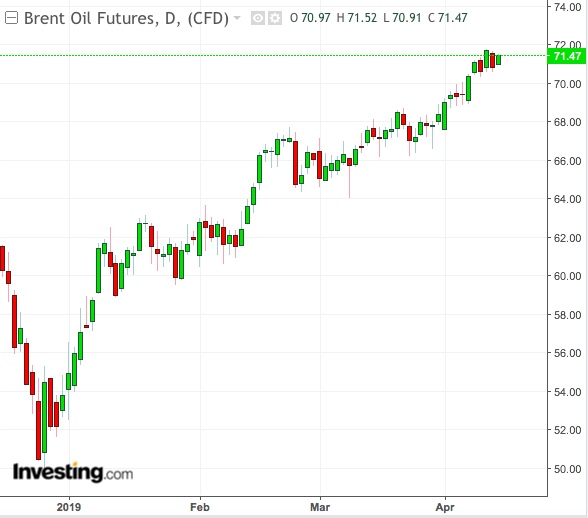Once again, OPEC is cutting production in shocking style, and again hedge funds are responding by pushing oil prices to higher levels each week.
And once again, the seeds to the next crude market destruction are possibly being planted without many realizing it, until the implosion catches everyone by surprise.

The clearest signs that it could be time to pull the brakes on the oil rally emerged on Thursday from a couple of Reuters reports and a warning by the Paris-based International Energy Agency (IEA) that suggested prices at above $70 per barrel may be unsustainable for now.
Of the two Reuters reports, one said the 14-member OPEC, and its ten other oil-producing allies led by Russia, may have to stop their output cuts by July if Venezuelan and Iranian supply keeps dropping and prices continue rallying.
Market Could Over-Tighten If OPEC Doesn’t Raise Output
This is because extending production in such a situation could over-tighten the market, the Reuters report said.
Quoting an OPEC source, Reuters said:
“If there was a big drop in supply and oil went up to $85, that’s something we don’t want to see, so we may have to increase output.”
Meanwhile, the IEA stressed in its monthly report for April that demand was a “very important” piece of the equation for oil market rebalancing and the less-than-stellar outlook for the global economy posed much uncertainty to that now.
Mixed Signals On Health Of Global Economy, IEA Warns
Elaborating, the agency said:
“As far as 2019 is concerned, amongst the analyst community there is an extraordinarily wide divergence of views as to how strong growth will be.”
“We maintain our forecast of 1.4 million barrels per day, but accept that there are mixed signals about the health of the global economy, and differing views about the likely level of oil prices.”
U.S. West Texas Intermediate crude and U.K.-traded global oil benchmark Brent fell more than 1% each on Thursday, posting their sharpest one-day retreat in three weeks on those cautions.
But barely 24 hours later, oil prices were up again, with traders chanting the mantra of cuts by the so-called OPEC+ group.
The manner in which fund managers are bidding up oil at any opportunity now is reminiscent of the events of 2014 before the first shale-driven market crash, warned Reuters oil columnist John Kemp in another article on Thursday.
He wrote that, then as now, expanding U.S. sanctions and other unplanned disruptions, such as strife in Libya, were key to pushing “prices higher in the short term and setting the stage for the next slump”.
Many Similarities Between Now And Pre-2014 Crash
Kemp presented startlingly similar situations in this year’s oil market versus five years back to show the potentially perilous path in which the trade was headed.
Kemp wrote:
“In 2013/14, U.S. sanctions on Iran, as well temporary disruptions - some actual, others threatened - caused by fighting in Libya and the advance of Islamist fighters across northern Iraq helped keep prices well above $100 per barrel.”
“Saudi Arabia and other OPEC members with spare capacity were slow to respond, insisting the market remained adequately supplied and prices were not too high.”
“But hedge funds and other money managers boosted their bullish net long position in crude futures and options to 626 million barrels in late June 2014, up from 367 million six months earlier, accelerating the price increase.”
“And production problems and high prices fuelled the final stages of the first frenzied U.S. shale drilling boom, causing output to surge, while dampening consumption growth.”
Kemp’s warning may be prescient as U.S. crude production has hit all-time highs of 12.2 million barrels after a pickup in drilling activity, which had slowed since February.
Buying Mania Counterintuitive To Oil
Scott Shelton, energy futures broker at ICAP in Durham, N.C., cited various reasons on Thursday as to why the current buying mania by oil-focused Commodity Trading Advisors, or hedge funds, was counterintuitive, particularly to U.S. crude.
Said Shelton:
"I see a market that isn’t short any more with CTA longs, and index-length now nearly 100% in the front-end of WTI.”
“There are a lot signals here to me that the market may be ready to retrace, not only on WTI spreads but also on flat price."
He added:
"I don’t want to discount that as it can take the market ‘out of value’ as it did late last year when prices went under $50 and ended up at $42. The only exception is that the fall at the end of the year was during the holidays, which means risk taking was at a minimum."
Time To Sell When Wall Street Says Buy?
Acting as cheerleaders to the current oil rally, Wall Street banks led by Goldman Sachs (NYSE:GS) have been raising their price forecasts for crude in recent weeks, focusing on tight supply rather than the economic conditions that would support the market.
Last year, several banks called for $100 oil as Brent neared $90. Suddenly, the market reversed on unexpected sanction waivers on Iranian oil approved by President Donald Trump. WTI crashed 40% in the fourth quarter, hitting a low of $42.36 on Dec. 24 before finishing 2018 at $45.10.
Ignoring the IEA's less-than-optimistic demand outlook now, RBC Capital on Thursday predicted $80 Brent by summer, warning that "many wounded bulls remain following the Q4′18 washout”.
But Shelton said such optimism spun by banks was often a sign to sell.
He adds:
“No offense to bank research, but ‘tight markets’ as reason for a rally often are blamed on a reason not to be short. I always think that is more of a spread/differential trade rather than a flat price trade.”
